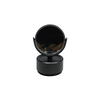Quick Overview
Double Sides Plane/Concave Mirror. For BM05030101 Monocular Biological Microscope.
BM05035411 Mirror
Mirror
| Mirror Type | Double Sides Plane/Concave Mirror |
| Mirror Rotatable Range | 360° |
| Mirror Diameter | Dia. 44mm |
| Surface Treatment | Polished |
| Material | Glass |
| Color | White |
| Net Weight | 0.06kg (0.13lbs) |
| Applied Field | For BM05030101 Monocular Biological Microscope |
Technical Info
Instructions
IlluminatorClose Λ
| The conditions of different illumination of the microscope are a very important parameter. Choosing the correct illumination method can improve the resolution and contrast of the image, which is very important for observing the imaging of different objects. The wavelength of the light source is the most important factor affecting the resolution of the microscope. The wavelength of the light source must be smaller than the distance between the two points to be observed in order to be distinguished by the human eye. The resolution of the microscope is inversely proportional to the wavelength of the light source. Within the range of the visible light, the violet wavelength is the shortest, providing also the highest resolution. The wavelength of visible light is between 380~780nm, the maximum multiple of optical magnification is 1000-2000X, and the limit resolution of optical microscope is about 200nms. In order to be able to observe a much smaller object and increase the resolution of the microscope, it is necessary to use light having a much shorter wavelength as the light source. The most commonly used technical parameters for describing illumination are luminescence intensity and color temperature. Luminescence intensity, with lumen as unit, is the physical unit of luminous flux. The more lumens, the stronger the illumination. Color temperature, with K (Kelvin) as unit, is a unit of measure indicating the color component of the light. The color temperature of red is the lowest, then orange, yellow, white, and blue, all gradually increased, with the color temperature of blue being the highest. The light color of the incandescent lamp is warm white, its color temperature is 2700K, the color temperature of the halogen lamp is about 3000K, and the color temperature of the daylight fluorescent lamp is 6000K. A complex and complete lighting system can include a light source, a lampshade or lamp compartment, a condenser lens, a diaphragm, a variety of wavelength filters, a heat sink cooling system, a power supply, and a dimming device etc. Select and use different parts as needed. Of which, selection and use of the illuminating light source is the most important part of the microscope illumination system, as and other components are designed around the illuminating wavelength curve and characteristics of the illuminating light source. Some of the microscope light sources are pre-installed on the body or frame of the microscope, and some are independent. There are many types and shapes of light sources. Depending on the requirements of the microscope and the object to be observed, one type or multiple types of illumination at the same time can be selected. In addition, the whole beam and band adjustment of the light source, the position and illumination angle of the light source, and the intensity and brightness of the light all have a great influence on the imaging. For microscope imaging, a good lighting system may be a system that allows for more freedom of adjustment. In actual work, such as industry, too many adjustment mechanisms may affect the efficiency of use, therefore choose the appropriated configured lighting conditions is very important. |
MirrorClose Λ
| Usually, a plane mirror or a concave mirror is used under the stage to reflect external light source illumination. This kind of concave mirror is generally used in low magnification objective lens without a condenser. Some reflection mirrors can use natural light directly for reflection in microscope illumination without the need to use a power source and a light bulb for lighting. When high-intensity glare illumination is required, but also continuous-band incandescent or halogen lamps must be used, the use of a mirror or reflector can effectively eliminate the uneven illumination of the image by the filament of the incandescent lamp or the halogen lamp. |
PackagingClose Λ
| After unpacking, carefully inspect the various random accessories and parts in the package to avoid omissions. In order to save space and ensure safety of components, some components will be placed outside the inner packaging box, so be careful of their inspection. For special packaging, it is generally after opening the box, all packaging boxes, protective foam, plastic bags should be kept for a period of time. If there is a problem during the return period, you can return or exchange the original. After the return period (usually 10-30 days, according to the manufacturer’s Instruction of Terms of Service), these packaging boxes may be disposed of if there is no problem. |
| Packing | |
| Packaging Type | Carton Packaging |
| Packaging Material | Corrugated Carton |
| Inner Packing Material | Plastic Bag |
| Ancillary Packaging Materials | Sponge |
| Gross Weight | 0.15kg (0.33lbs) |
| Minimum Packaging Quantity | 1pc |
| Transportation Carton | Carton Packaging |
| Transportation Carton Material | Corrugated Carton |
| Transportation Carton Dimensions(1) | 15.2x15.2x15.2cm (6x6x6″) |
| Total Gross Weight of Transportation(kilogram) | 0.15 |
| Total Gross Weight of Transportation(pound) | 0.33 |











